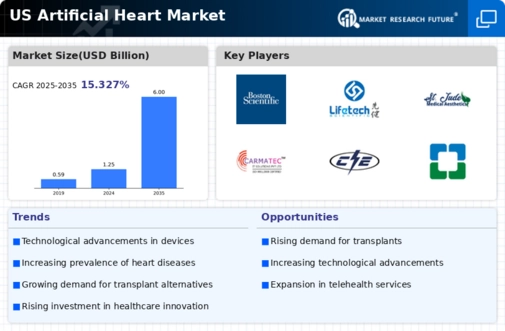The US Artificial Heart Market is characterized by intense competition among key players who are striving to innovate and improve their product offerings. As the prevalence of heart diseases continues to escalate, the demand for artificial hearts to treat severe cases of heart failure is rising. Various companies are focusing on research and development to create devices that enhance patient outcomes and address the limitations of existing technologies. The market landscape is influenced by several factors, including regulatory approvals, technological advancements, partnerships, and collaborations that companies pursue to stay ahead in the competitive scenario.
With an increasing aging population and growing awareness about cardiovascular diseases, companies are continuously looking to capture market share through differentiated product strategies and effective marketing initiatives.
Medtronic, a leading player in the US Artificial Heart Market, has established a significant presence due to its robust range of cardiovascular devices and solutions. The company is known for its innovative ventricular assist devices, which are crucial for patients who are not candidates for heart transplants or are awaiting transplantation. Medtronic's strengths lie in its comprehensive research and clinical programs aimed at validating the effectiveness of its products. The company’s commitment to advancing technology for cardiac support is evident in its continuous investment in R&D, helping to maintain a competitive edge.
Additionally, Medtronic benefits from an extensive distribution network and collaborations with healthcare systems, which enable it to reach a wider patient base and enhance its market penetration across the United States.
Abbott Laboratories is another formidable entity in the US Artificial Heart Market, recognized for its advancements in heart implant technologies. The company offers a variety of products like left ventricular assist devices and has made notable advancements in heart failure management. With a strong portfolio, Abbott Laboratories strengthens its position through its commitment to innovation and a focus on patient-centric solutions. The company has engaged in strategic mergers and acquisitions to amplify its capabilities and expand its technological reach within the cardiovascular sector.
These initiatives have not only provided Abbott with enhanced expertise but have also produced synergies that bolster its market presence. The combination of a diverse product line, strong R&D focus, and strategic partnerships contributes to Abbott Laboratories' competitive strengths in the US Artificial Heart Market.


















